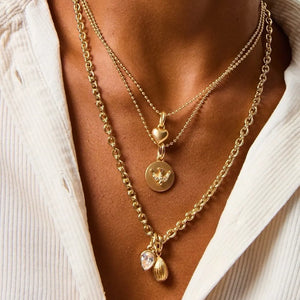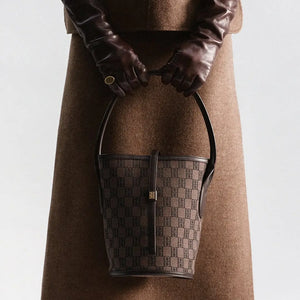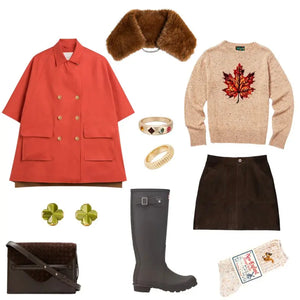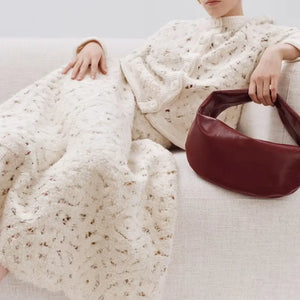
Instagram/@sezane
What does your perfect morning look like? Maybe it's that first sip of coffee, or five minutes of actual peace before the chaos starts. But here's what it should definitely include: walking up to your closet, opening those doors, and actually feeling... calm. Not that crushing overwhelm of too many choices. Not that panic of having literally nothing to wear. Just this weird sense of confidence that yeah, you've got what you need.
That's what I call the Goldilocks Wardrobe—and honestly, it took me way too long to figure out it even existed.
The fashion industry would have you believe you need endless options. Then you've got those hardcore minimalists swearing that exactly 33 items will somehow revolutionize your entire existence. (Spoiler: they won't.) The perfect harmony? It's hiding somewhere in the messy middle—in a balance that nobody else can figure out for you. After spending years watching how people actually deal with their clothes—the good, the bad, and the "why do I own seven navy sweaters?"—I've noticed a pattern that cuts through all the noise.
The Clothing Ecosystem Theory

Instagram/@farmrio
So here's the thing: your wardrobe is basically its own little ecosystem. Stay with me here. In nature, healthy ecosystems have biodiversity without descending into total chaos, right? Everything has its place, its purpose. There's this natural balance between having enough variety and not going completely overboard. Your closet? Same deal. It needs to be varied enough to handle whatever life throws at you (surprise dinner party, anyone?), but organized enough that you actually wear the stuff you own.
Most capsule wardrobe advice treats clothing like there's some universal equation. "33 items for 3 months!" Sure, Jan. Because obviously a freelance writer working from their couch in Portland needs exactly the same wardrobe as a lawyer strutting through Manhattan. The real answer to how many clothes you should own is annoyingly, wonderfully personal.
The Formula That Changed Everything

Instagram/@boden
Alright, here's the framework that actually works. I call it the Lifestyle Multiplication Method:
Step 1: Calculate Your Base Number

Instagram/@sezane
First things first—when do you do laundry? Weekly? You need about 7-10 days' worth of clothes. More of a "I'll do it when I run out of underwear" person? (Hey, no judgment here.) Then you're looking at 14-18 days. That's your magic multiplier.
Step 2: Identify Your Life Categories

Instagram/@jcrew
List your regular activities. It might look something like:
- Work from home (let's say every day)
- Social outings (2-3 times/week)
- Exercise (let's be optimistic: 4 times/week)
- Errands/casual (daily)
- Special occasions (monthly)
Step 3: Apply the Formula

Instagram/@alc_ltd
Here's where the math happens. For each category, multiply your base number by how often you do that thing. Office job five days a week? You need 5x your multiplication factor in work clothes. Work from home? Maybe 2x in "decent enough for video calls" tops and like, one full professional outfit for when you need to look like a real adult.
Step 4: The Reality Adjustment

Instagram/@akris
And this is where it gets real. Whatever number you just calculated? Add 20%. I call this the "life happens" buffer. Because your favorite shirt will absolutely be in the hamper when you need it. Weather will do something weird. Someone will spill coffee on you. Trust me on this one.
Breaking Down the Numbers

Instagram/@reformation
So let's say you do laundry every two weeks, prefer wearing things once before washing. Here's roughly how it shakes out:
Tops: 20-25 total
- 8 casual/everyday (because WFH life)
- 5 going-out/social
- 4 athletic
- 2 dressy/special occasion
- 1-3 seasonal layers
Bottoms: 10-14 total
- 5 everyday pants/jeans
- 3 athletic/lounge
- 2 dressy/work appropriate
- 1-3 seasonal (shorts/skirts)
Dresses/Jumpsuits: 4-8
- 2-3 casual day dresses
- 2 dinner/event appropriate
- 1 formal
- 1-2 seasonal
Outerwear: 4-6 pieces
- 1 rain jacket
- 1 warm coat
- 1 blazer/structured jacket
- 1-2 light layers
Shoes: 7-10 pairs
- 2-3 everyday (sneakers, flats, boots)
- 2 athletic
- 1-2 dressy
- 1-2 sandals/seasonal
- 1 special purpose (those hiking boots I swear I'll use more)
Total: 45-63 pieces (not counting underwear and accessories)
The Psychology of "Enough"

Instagram/@acler
Can we talk about something nobody mentions? Finding your clothing balance is way more psychological than practical. That whole "I have nothing to wear" meltdown while staring at a full closet? Yeah, that's not about actually having nothing. It's decision fatigue. Or terrible organization. Or—and this one hits hard—clothes that don't match who you are anymore.
Through totally unscientific observation, I've noticed most people hit their stride somewhere around 50-60 pieces total. Drop below 45 and things start feeling tight—like you're constantly doing laundry or wearing the same thing repeatedly. Creep above 65 and suddenly you're buying duplicates because you forgot you already owned that white tee. But hey, your number might be totally different. That's kind of the whole point.
The Seasonal Float

Instagram/@acler
Okay, unless you're living in San Diego (jealous), seasons are a thing. The "70/30 rule" might be a game-changer: about 70% of your wardrobe works year-round, and 30% rotates with the seasons. No more giant bins labeled "SUMMER CLOTHES" taking up half your closet. Just swap out maybe 12-15 pieces twice a year and call it good.
Quality Checkpoints

Instagram/@aguabyaguabendita
Numbers are only part of the story. Here's how to know if you're on the right track:
The Hanger Test: Empty hangers just chilling in your closet for over a month? You might own too much. Constantly stealing hangers from other clothes? Time to reassess.
The Laundry Panic Index: Okay, real talk. How often are you standing there in a towel, texting friends that you'll be late because literally everything is dirty? Once a month—totally normal. Once a week? Either you need more clothes or, you know, a better relationship with your washing machine.
The Joy-to-Guilt Ratio: Open your closet. You should feel mostly good about what you see. Maybe 10-15% "meh" items—that's normal. But if more than 20% of your stuff makes you feel guilty, stressed, or just blah? Time for a serious edit.

Instagram/@astrthelabel
The Outfit Formula Success Rate: Can you throw together an outfit for any normal situation in under 5 minutes? If "what to wear to dinner" turns into a 30-minute archaeological dig through your closet... well, you know what I'm going to say.
The Investment Reality

Instagram/@shopdoen
Money talk time. Because ignoring the financial side is exactly how you end up with a closet full of "it was on sale!" regrets. Say you own 55 pieces and refresh 20% each year (which is pretty reasonable). That's 11 new things annually. Budget for that. Seriously—11 pieces you absolutely love beats 50 mediocre "deals" every single time.
Special Circumstances Adjustments

Instagram/@boden
Uniform Jobs: Scrubs, uniforms, super strict dress codes—don't count these as part of your regular wardrobe. They're work equipment, not clothes.
Extreme Climates: Add 20-30% if you live somewhere with dramatic seasons. Minnesota residents legitimately need three weights of coat. Miami residents need one rain jacket and that's sufficient.
Multi-Sport Athletes: Each serious sport adds 5-10 pieces. A runner needs different gear than a yogi. Don't feel guilty about activity-specific clothes if you actually do the activity.
New Parents: Add 30% more casual clothes and subtract 50% of dry-clean-only items. This adjustment is based on practicality and lifestyle changes.
The Edit Protocol

Instagram/@freepeople
Finding your number means honest editing. Here's an effective twice-yearly system:
- The Backwards Hanger Trick: Turn all hangers backwards. After wearing something, hang it normally. After 3 months, evaluate anything still backwards.
- The Body Check: Try on anything you're unsure about. If it doesn't fit your current body comfortably, it goes. Your closet is not a museum to your past or future self.
- The Repair Reality: If it's been "waiting to be hemmed" for over 6 months, be honest about whether you'll ever actually do it.
- The Duplicate Detective: How many navy sweaters does one person need? (Spoiler: probably not seven.)
Building Your Goldilocks Wardrobe

Instagram/@bytimo
Start where you are. Count what you have. Use the formula as a starting point, then adjust based on your actual life. Notice patterns—what do you grab constantly? What sits there judging you? Your magic number lives in that space between "I've worn these jeans four days straight" and "wait, when did I buy this?"
The goal? It's not about becoming a minimalist for Instagram or hoarding clothes like they'll stop making them. It's about building a wardrobe that actually works for your real life, makes mornings easier, and frees up brain space for literally anything more interesting than outfit stress.
Your Next Steps

Instagram/@isabelmarant
- Do the count: Actually count everything. The number might shock you. (It shocked me.)
- Run the formula: Calculate what you theoretically need for your lifestyle.
- Find the gaps: Where's the mismatch? Too many blazers for someone who works in pajamas? Zero athletic wear despite that new gym membership?
- Edit thoughtfully: Let go of what's not working. Fill actual gaps, not imaginary ones.
- Track and adjust: Finding your perfect number is a process. It took me three seasons. That's totally fine.
The Bottom Line

Reiss at reiss.com
Look, after years of wardrobe experiments (both clients' wardrobes and mine), here's what I know: The right amount of clothes is whatever lets you get dressed without drama, brings more joy than stress, and leaves room—in your closet and your head—for stuff that actually matters.
Most people can land somewhere in that 45-65 piece range. But honestly? The only wrong answer is the number that has you standing at your closet every morning feeling defeated by something as basic as putting on pants.
Now, if you'll excuse me, I've got some closets to rescue from chaos. One slightly-worn hanger at a time.




